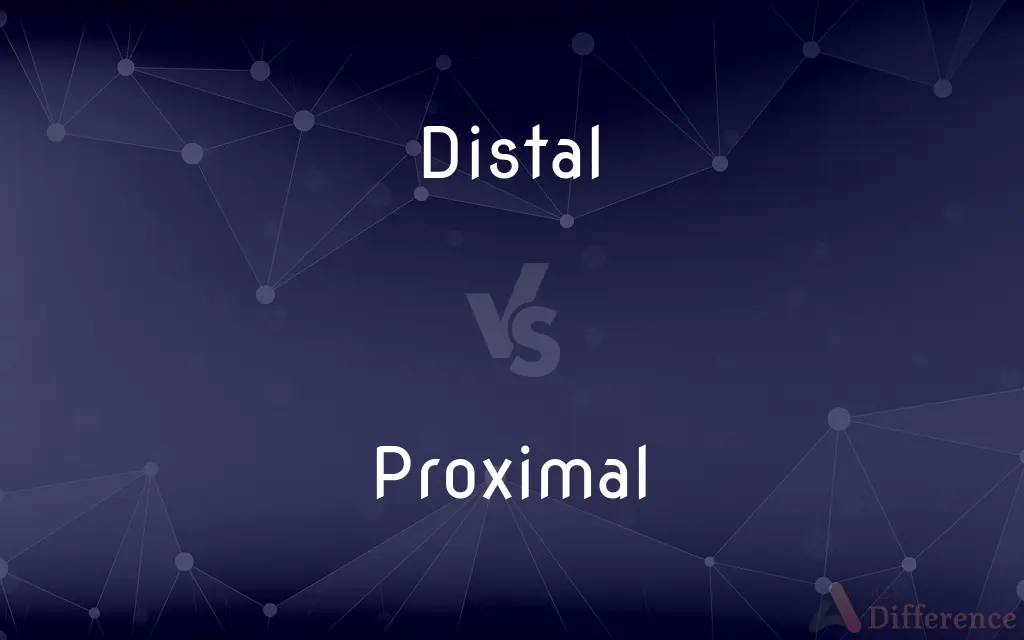Distal vs. Proximal — What's the Difference?
Edited by Tayyaba Rehman — By Fiza Rafique — Updated on September 21, 2023
Distal refers to a location farther from a point of reference, usually the center of the body or point of attachment. Proximal means closer to the point of reference. Both terms are mainly used in anatomy and medicine to describe relative positions.

Difference Between Distal and Proximal
Table of Contents
ADVERTISEMENT
Key Differences
The terms Distal and Proximal are primarily used in the fields of anatomy, medicine, and biology to describe the relative positions of different parts of the body or of a particular structure. Distal denotes that something is farther away from a specific reference point, typically the center of the body or the point where a limb attaches to the body. Proximal, on the other hand, means that something is closer to this point of reference.
When discussing anatomical relationships, Distal and Proximal are crucial in providing clear, unambiguous descriptions. For instance, in a human arm, the hand is distal to the elbow, meaning it is farther away from the point of attachment to the body. The elbow, conversely, is proximal to the hand, as it is closer to where the arm attaches to the torso.
In terms of etymology, Distal is derived from the Latin word 'distare,' which means 'to stand apart from,' while Proximal comes from the Latin 'proximus,' meaning 'nearest.' These roots effectively summarize the essence of what each term represents: distal conveys separation or distance, and proximal implies nearness.
In addition to human anatomy, the terms Distal and Proximal are used in other scientific contexts. For instance, in dentistry, one might refer to surfaces of the teeth as being distal or proximal to each other, relative to their position in the dental arch. In geology, the terms may be used to describe the position of rock formations in relation to a central point.
Comparison Chart
Relative Position
Farther from reference
Closer to reference
ADVERTISEMENT
Fields of Use
Anatomy, Medicine
Anatomy, Medicine
Etymological Origin
Latin 'distare'
Latin 'proximus'
Implies
Separation or distance
Nearness or closeness
Examples
Hand is distal to elbow
Elbow is proximal to hand
Compare with Definitions
Distal
Common in medical and anatomical contexts.
The surgeon focused on the distal part of the artery.
Proximal
Common in medical and anatomical terminology.
The doctor examined the proximal part of the digestive tract.
Distal
Sometimes used in non-medical fields like geology.
The distal end of the lava flow reached the ocean.
Proximal
Closer to the point of attachment or origin.
The shoulder is proximal to the elbow.
Distal
Indicates separation or distance.
The distal consequences of a decision may not be immediately clear.
Proximal
Used to describe anatomical closeness.
The proximal end of the humerus is near the shoulder.
Distal
Situated away from the centre of the body or from the point of attachment
The distal end of the tibia
Proximal
May refer to time, indicating immediacy.
The proximal effects of the medication were noticeable within hours.
Distal
Anatomically located far from a point of reference, such as an origin or a point of attachment.
Proximal
Indicates nearness or closeness.
The proximal cause of the accident was driver error.
Distal
Situated farthest from the middle and front of the jaw, as a tooth or tooth surface.
Proximal
Situated nearer to the centre of the body or the point of attachment
The proximal end of the forearm
Distal
Remote from the point of attachment or origin.
The distal end of a bone or muscle
Proximal
Nearest; proximate.
Distal
(dentistry) Facing the wisdom tooth or temporomandibular joint on the same side of the jaw.
Proximal
(Anatomy) Nearer to a point of reference such as an origin, a point of attachment, or the midline of the body
The proximal end of a bone.
Distal
(linguistics) Far or farther from the speaker.
Proximal
Closer to the point of attachment or observation.
Distal
Remote from the point of attachment or origin; as, the distal end of a bone or muscle
Proximal
(dentistry) Facing toward another tooth. The proximal surfaces of a tooth are those that touch or are close to neighboring teeth.
Distal
Situated farthest from point of attachment or origin, as of a limb or bone
Proximal
(linguistics) Closer to the speaker.
Distal
Directed away from the midline or mesial plane of the body
Proximal
Toward or nearest, as to a body, or center of motion of dependence; proximate.
Distal
Farther from the point of attachment or origin.
The fingers are distal to the wrist.
Proximal
Situated near the point of attachment or origin; as, the proximal part of a limb.
Distal
Used to describe relative anatomical positions.
The distal end of the femur is at the knee.
Proximal
Situated nearest to point of attachment or origin;
The proximal end of a bone
Common Curiosities
Are Distal and Proximal opposites?
Yes, they are relative opposites in describing anatomical positions.
What does Proximal mean?
Proximal refers to a location closer to a specific point of reference, often the body's center or a point of attachment.
Can Distal and Proximal be used in non-medical contexts?
While rare, they can sometimes appear in fields like geology or in describing cause-and-effect relationships.
Where are these terms commonly used?
They are primarily used in anatomy, medicine, and related scientific fields.
Is the elbow Distal or Proximal to the shoulder?
The elbow is distal to the shoulder.
Can Proximal refer to time?
Yes, it can refer to immediate or near-term effects in time.
What does Distal mean?
Distal refers to a location farther from a specific point of reference, usually the body's center or a point of attachment.
Is the hand Distal or Proximal to the elbow?
The hand is distal to the elbow.
Can Distal refer to time?
Rarely. It mainly describes spatial relationships.
What is the etymological origin of Distal?
It comes from the Latin word 'distare,' meaning 'to stand apart from.'
Is the knee Proximal or Distal to the hip?
The knee is distal to the hip.
Are Distal and Proximal universal terms?
In medical and anatomical contexts, they are universally understood to describe relative positions.
What is the etymological origin of Proximal?
It comes from the Latin word 'proximus,' meaning 'nearest.'
Is Proximal used more frequently than Distal?
Both terms are used equally depending on the context.
Is the ankle Proximal or Distal to the knee?
The ankle is distal to the knee.
Share Your Discovery

Previous Comparison
Domain vs. Range
Next Comparison
Hairstyle vs. ForelockAuthor Spotlight
Written by
Fiza RafiqueFiza Rafique is a skilled content writer at AskDifference.com, where she meticulously refines and enhances written pieces. Drawing from her vast editorial expertise, Fiza ensures clarity, accuracy, and precision in every article. Passionate about language, she continually seeks to elevate the quality of content for readers worldwide.
Edited by
Tayyaba RehmanTayyaba Rehman is a distinguished writer, currently serving as a primary contributor to askdifference.com. As a researcher in semantics and etymology, Tayyaba's passion for the complexity of languages and their distinctions has found a perfect home on the platform. Tayyaba delves into the intricacies of language, distinguishing between commonly confused words and phrases, thereby providing clarity for readers worldwide.













































